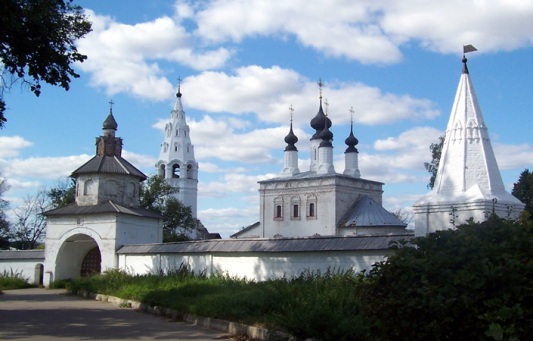

Location: Suzdal
Constructed: 1240
Aleksandrovskiy Convent () was constructed in 1240 by a famous Russian prince Aleksandr Nevsky. Original wooden buildings were not preserved. Most of the current religious complex was rebuilt in stone and brick in the late 17th century and early 18th century with money donated by many notable families including Natalia Kirilovna, mother of Peter I the Great. The life of Russian Orthodox community ended in 1764, when Russian Empress Catherine II the Great secularized many abbeys in the country. Aleksandrovskiy Convent was closed and its remaining churches served residents of Suzdal. The abbey was revived in 2006 as a male Orthodox community.
According to legend, it was founded in 1240 by Alexander Nevsky. The
monastery received estates from Alexander Nevsky's relatives - Ivan
Kalita and Ivan II. Due to the large number of nuns who became orphans
and went to the monastery after the Tatar invasion, it was called the
Great Lavra.
In 1608-1610, the monastery was burned by the Poles
during the Russo-Polish War. Not a single building erected before the
17th century has survived.
The city inventory of 1628 describes
the monastery as follows: “in Suzdal, in the Alexander settlement, the
outer monastery is the church of Alexander the Martyr, wooden up, and
the warm church of the Protection of the Holy Mother of God, wooden
dumplings, the sovereign’s church building on the monastery, 38 cells,
and in them the abbess Olga and 44 elders, a wooden fence, the Holy
Gate, and other Water Gates; and they take money from the Bolshovo
parish, and bread from the palace.”
In 1764, when Catherine II
secularized the lands, the Alexander Convent was abolished and the
cathedral was converted into a parish church of the city.
In
2006, it was restored as a monastery for men of the Vladimir-Suzdal
diocese.
The ancient monuments of the monastery have not survived to this day.
The Church of the Ascension of the Lord with a bell tower was built in
1695 at the expense of Tsarina Natalia Kirillovna, mother of Peter I.
The Ascension Church is a high two-tiered quadrangle, crowned with
five domes. A large apse adjoins the quadrangle on the eastern side, a
warm side-chapel is attached to the northern side, and a porch is
attached to the east. The windows are decorated with carved frames with
simple columns in the first tier and figured ones in the second. Figured
columns are also used in the decor of the tall, soaring drums.
The octagonal pillar of the tented bell tower is placed on a low
quadrangle, to which a wooden staircase is attached. Its walls are
practically devoid of decor, which makes it unique among Suzdal tented
bell towers. The upper part is modestly decorated with carved frames of
arched openings and frames above dormer windows.
In the first
half of the 18th century, a low fence was built around the monastery,
decorated with decorative turrets stylized as defensive towers. At the
same time, the Holy Gates with a two-tiered turret appeared, reminiscent
of the Holy Gates of the Trinity Monastery, now part of the
Rizopolozhensky Monastery ensemble. This coincidence is not accidental:
the fence and towers of the Alexander Monastery were erected under the
supervision of Ivan Gryaznov, who participated in the construction of
the Trinity and Rizopolozhensky Monasteries at the end of the 17th
century.